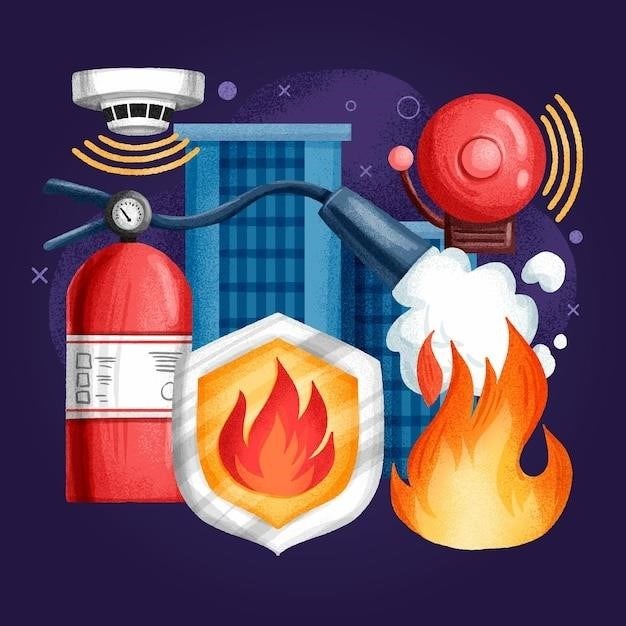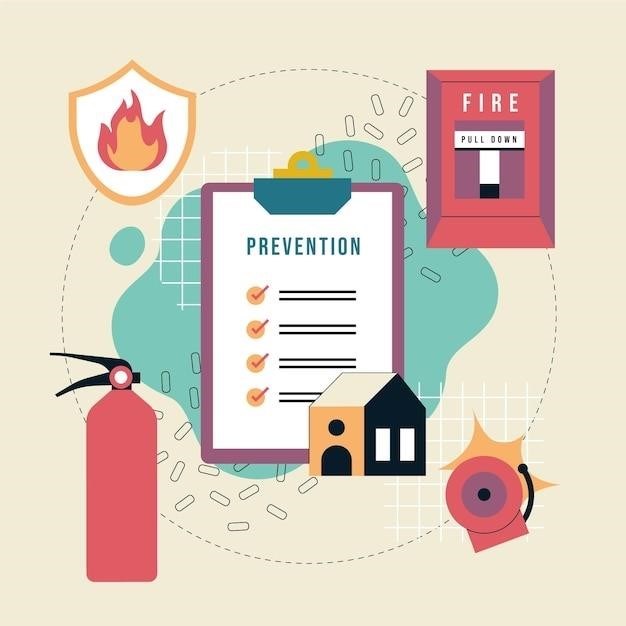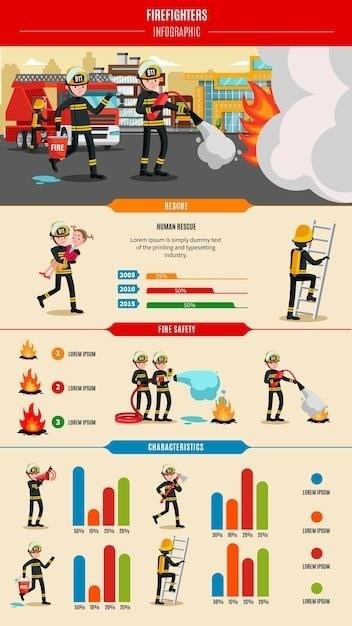NFPA 20⁚ Standard for the Installation of Stationary Fire Pumps
NFPA 20‚ the Standard for the Installation of Stationary Fire Pumps‚ is a crucial document for ensuring fire safety. It outlines requirements for the selection‚ installation‚ and maintenance of these critical systems. Access to the latest NFPA 20 PDF is essential for compliance and protecting life and property. The standard is regularly updated to reflect advancements in technology and best practices.
NFPA 20‚ formally titled “Standard for the Installation of Stationary Fire Pumps‚” is a comprehensive document published by the National Fire Protection Association (NFPA). This standard serves as a vital guide for the design‚ installation‚ testing‚ and maintenance of stationary fire pumps‚ crucial components in fire protection systems. It details the requirements for ensuring these pumps reliably deliver adequate water supplies during fire emergencies‚ protecting lives and property. The NFPA 20 PDF‚ readily available online and through NFPA’s official channels‚ is an indispensable resource for fire protection engineers‚ contractors‚ and inspectors. Understanding and adhering to its provisions are paramount for compliance with fire safety regulations and effective fire suppression.
The standard covers various aspects of fire pump systems‚ from pump selection and capacity calculations to the design of associated piping‚ valves‚ and controls. It also addresses power supply requirements‚ ensuring that the pumps receive reliable electrical power‚ and includes guidelines for the installation of diesel-powered backup systems. The NFPA 20 PDF provides detailed technical specifications‚ diagrams‚ and illustrations to assist in proper implementation. Regular updates to the standard reflect technological advances and evolving best practices in the field of fire protection.
Key Requirements of NFPA 20
NFPA 20 outlines several key requirements for the installation and maintenance of stationary fire pumps. These encompass pump selection based on fire flow demands‚ ensuring sufficient water pressure and volume for effective fire suppression; The standard dictates specific criteria for pump location‚ including considerations for accessibility‚ protection from environmental hazards‚ and proximity to water sources. Proper piping design‚ incorporating appropriate valves‚ fittings‚ and strainers‚ is also crucial‚ as detailed in the NFPA 20 PDF. Furthermore‚ the standard addresses the need for reliable power sources‚ specifying requirements for electrical connections‚ generator backup systems‚ and emergency power transfer switches. Regular testing and inspection‚ including hydrostatic testing to verify pump integrity and performance testing to confirm flow rates‚ are mandated to maintain system readiness.
The NFPA 20 PDF emphasizes comprehensive documentation‚ requiring records of all inspections‚ tests‚ and maintenance activities. These records demonstrate compliance and provide valuable historical data for future system evaluations. The standard also covers the use of appropriate materials and finishes for pump components to ensure corrosion resistance and longevity. Finally‚ NFPA 20 incorporates safety measures for personnel working on or near fire pump systems‚ addressing issues such as lockout/tagout procedures and personal protective equipment requirements. Adherence to these key requirements is paramount for maintaining a reliable and efficient fire protection system.
NFPA 20 Editions and Revisions
The NFPA 20 Standard for the Installation of Stationary Fire Pumps undergoes regular revisions to incorporate advancements in technology‚ updated safety practices‚ and feedback from industry professionals. Each edition builds upon previous versions‚ refining existing requirements and introducing new ones as needed. Staying current with the latest edition is crucial for compliance and ensuring the effectiveness of fire protection systems. The NFPA website and authorized distributors provide access to the most recent NFPA 20 PDF‚ allowing users to download and review the current standards. Obtaining the latest version is essential‚ as earlier editions might not reflect the most up-to-date safety protocols and technological improvements in fire pump design and operation. Significant changes between editions are often highlighted in the introductory sections of the PDF document‚ enabling users to quickly identify key updates and modifications.
Regularly reviewing these changes ensures that fire protection systems are designed‚ installed‚ and maintained according to the highest safety standards. The NFPA actively engages in a continuous improvement process‚ soliciting input from stakeholders to identify areas for refinement and enhancement. This collaborative approach ensures that NFPA 20 remains a relevant and effective resource for protecting life and property in the event of a fire. By accessing and utilizing the latest NFPA 20 PDF‚ users can confidently contribute to the safety and reliability of their fire protection systems.
Accessing NFPA 20 PDF Documents
Accessing the official NFPA 20 PDF requires navigating to the official NFPA website. Direct downloads are typically not available; instead‚ the NFPA operates a purchasing system; This ensures that users receive the most up-to-date version and supports the organization’s efforts in maintaining and updating its standards; The process usually involves creating an account and adding the desired document to a shopping cart. Payment methods vary‚ but options generally include credit cards and potentially purchase orders for larger organizations. Once the purchase is complete‚ the PDF version of NFPA 20 can be downloaded. It’s important to verify the authenticity of any downloaded PDF to ensure that it’s the official version from the NFPA and not a potentially outdated or inaccurate copy. Unauthorized copies may lack crucial updates and corrections‚ jeopardizing the safety and reliability of fire protection systems.
Alternatively‚ authorized distributors of NFPA standards can also provide access to the NFPA 20 PDF. These distributors often offer both physical and digital copies‚ catering to various user preferences. However‚ it is always recommended to purchase directly from the NFPA or a reputable authorized distributor to guarantee authenticity and support the ongoing development and maintenance of these vital safety standards. Purchasing the official document ensures access to the most current version with all necessary updates and corrections‚ contributing to the overall reliability and effectiveness of fire protection measures.
Importance of Adhering to NFPA 20 Standards
Strict adherence to NFPA 20 is paramount for ensuring the reliable performance of fire pump systems during emergencies. These systems are crucial for protecting lives and property‚ and any deviation from the standard’s guidelines can compromise their effectiveness. NFPA 20 details critical aspects of fire pump design‚ installation‚ testing‚ and maintenance‚ all of which contribute to the overall reliability of the system. Failure to meet these standards can lead to inadequate water pressure or flow rates during a fire‚ hindering firefighting efforts and increasing the risk of significant property damage or loss of life. The consequences of non-compliance can extend beyond immediate emergencies‚ potentially leading to costly repairs‚ legal liabilities‚ and insurance complications. Regular inspections and testing‚ as mandated by NFPA 20‚ are vital for identifying and addressing potential issues before they escalate into serious problems. This proactive approach helps maintain the system’s operational readiness and ensures its ability to perform as intended when needed most. By diligently following the guidelines of NFPA 20‚ stakeholders demonstrate a commitment to prioritizing safety and fulfilling their responsibilities in protecting the community and the environment.
Furthermore‚ adherence to NFPA 20 demonstrates a commitment to best practices and industry standards‚ reducing the risk of legal and financial repercussions. Insurance companies often require compliance with NFPA 20 as a condition for coverage‚ and failure to meet these standards can jeopardize insurance claims in the event of a fire.
Inspection‚ Testing‚ and Maintenance (ITM) as per NFPA 20
NFPA 20 mandates a comprehensive Inspection‚ Testing‚ and Maintenance (ITM) program for stationary fire pumps to ensure their readiness during emergencies. This program outlines specific procedures and frequencies for various tests‚ including visual inspections‚ operational testing‚ and performance testing. Visual inspections involve checking for physical damage‚ corrosion‚ leaks‚ and proper connections of all components. Operational testing verifies the pump’s ability to start and run‚ while performance testing assesses its ability to deliver the required water flow and pressure. The frequency of these tests varies depending on factors such as pump type‚ usage‚ and risk assessment. Hydrostatic testing‚ a crucial part of the ITM process‚ is performed to verify the integrity of the pump and piping system by pressurizing them to a specific level. Detailed records of all ITM activities must be maintained‚ documenting the date‚ type of test performed‚ results‚ and any corrective actions taken. This documentation is essential for demonstrating compliance with NFPA 20 and can be crucial in the event of a fire or insurance claim. Failure to adhere to the prescribed ITM schedule and procedures can lead to system malfunctions during a fire‚ jeopardizing life safety and property. Regular and thorough ITM is‚ therefore‚ critical for maintaining the reliability and effectiveness of the fire pump system.
NFPA 20 and Other Relevant NFPA Standards (e.g.‚ NFPA 25)

NFPA 20‚ while focusing on fire pump installation‚ interacts significantly with other NFPA standards to create a comprehensive fire protection system. NFPA 25‚ the Standard for the Inspection‚ Testing‚ and Maintenance of Water-Based Fire Protection Systems‚ is particularly relevant. NFPA 25 details the ITM procedures for the entire water-based system‚ including the fire pump‚ its associated piping‚ and other components like fire hydrants and sprinklers. Compliance with both NFPA 20 and NFPA 25 is essential to ensure the entire system functions correctly during a fire. Other standards might also apply depending on the specific system design. For example‚ standards addressing electrical systems (like those for power supply to the fire pump) or those concerning specific types of pumps might be relevant. Understanding the interplay between NFPA 20 and these other standards is critical for designers‚ installers‚ and inspectors to ensure the system’s reliability and effectiveness. The NFPA website provides access to these standards‚ allowing for a comprehensive understanding of their interdependencies and the overall fire protection strategy. Proper coordination among these standards is key to creating a fully functional and compliant fire safety system.
Differences between NFPA 20 and NFPA 25
While both NFPA 20 and NFPA 25 are vital for fire protection system integrity‚ they address distinct aspects. NFPA 20 concentrates solely on the installation of stationary fire pumps‚ covering their selection‚ placement‚ connections‚ and associated equipment like drivers and controllers. It ensures the pump is correctly integrated into the overall system‚ meeting performance and safety requirements. Conversely‚ NFPA 25 focuses on the inspection‚ testing‚ and maintenance (ITM) of the entire water-based fire protection system‚ including the fire pump. NFPA 25 outlines the regular procedures to verify the system’s readiness‚ encompassing tasks like hydrostatic testing‚ flow testing‚ and visual inspections. While NFPA 20 provides the foundation for a correctly installed pump‚ NFPA 25 ensures its ongoing operational reliability and preparedness. They are complementary‚ not mutually exclusive. A correctly installed pump (NFPA 20) is useless if it’s not properly maintained and tested (NFPA 25). Both standards are essential for ensuring a reliable fire suppression system‚ protecting lives and property. Understanding their individual roles is crucial for anyone involved in designing‚ installing‚ or maintaining a fire protection system.
Common Questions Regarding NFPA 20
Many questions arise concerning NFPA 20’s application. A frequent query involves the specific requirements for pump driver selection‚ encompassing considerations of power source reliability and redundancy. Questions about the necessary documentation‚ including testing and inspection records‚ are also common. Understanding the differences between various pump types and their suitability for different applications is another recurring theme. Compliance with NFPA 20 often leads to questions about the authority having jurisdiction (AHJ) and their role in ensuring adherence to the standard. The appropriate frequency of testing and maintenance‚ tailored to specific pump usage and type‚ is another area of frequent inquiry. Finally‚ questions regarding the implications of non-compliance and potential consequences for failing to meet NFPA 20 standards are frequently raised‚ emphasizing the seriousness of adhering to these vital safety guidelines. Clear understanding of these points is crucial for safe and effective fire protection systems.
Fire Pump Selection and Design Considerations
Selecting and designing fire pumps requires careful consideration of several critical factors. NFPA 20 provides guidance on pump type selection‚ matching pump capacity to the required fire flow‚ and ensuring sufficient pressure to reach the highest sprinkler head. The design must account for the water source‚ including its availability and pressure‚ and the potential for multiple pump operation. Important considerations include the pump’s location‚ accessibility for maintenance‚ and protection from environmental hazards. The design needs to integrate with the overall fire protection system‚ including piping‚ valves‚ and controls‚ ensuring seamless operation. Reliability is paramount‚ and the chosen pump and its components must meet stringent durability and performance standards. Factors such as the pump’s priming method‚ suction lift‚ and the necessary safety features‚ such as alarms and pressure gauges‚ are also essential aspects of the design process. Careful consideration of all these factors is critical for a fire pump system that effectively protects life and property.

Role of NFPA 20 in Fire Safety
NFPA 20 plays a pivotal role in ensuring fire safety by establishing comprehensive standards for the installation of stationary fire pumps. These pumps are critical components of water-based fire suppression systems‚ providing the necessary water pressure and flow rate to extinguish fires effectively. Adherence to NFPA 20’s guidelines ensures that fire pump systems are properly designed‚ installed‚ and maintained‚ maximizing their reliability and effectiveness during emergencies. The standard addresses various aspects‚ including pump selection‚ installation‚ testing‚ and maintenance procedures. By outlining these detailed requirements‚ NFPA 20 helps minimize the risks associated with fire pump failures. This ultimately contributes to the protection of lives‚ property‚ and the environment by ensuring a dependable water supply for fire suppression efforts. The standard’s influence extends to the design and construction of buildings‚ as well as the ongoing operation of fire protection systems within various facilities.
Consequences of Non-Compliance with NFPA 20
Failure to comply with NFPA 20 standards can lead to severe consequences‚ jeopardizing life safety and property. A malfunctioning fire pump due to improper installation or inadequate maintenance‚ as outlined in NFPA 20‚ can render a building’s fire suppression system ineffective during a fire emergency. This can result in significant property damage‚ potential loss of life‚ and substantial financial liabilities. Insurance companies may deny claims if a fire incident is linked to non-compliance with NFPA 20. Legal ramifications‚ including fines and lawsuits‚ can arise from negligence related to fire safety regulations. Furthermore‚ non-compliance can negatively impact a building’s occupancy permits and insurance ratings‚ leading to increased operational costs and potential business disruptions. Authorities conducting inspections may issue citations and demand immediate remediation‚ incurring additional expenses. Ultimately‚ prioritizing adherence to NFPA 20 is crucial for mitigating risks and ensuring responsible fire safety practices.
Resources for Obtaining NFPA 20
The primary source for acquiring the official NFPA 20 Standard for the Installation of Stationary Fire Pumps is the National Fire Protection Association (NFPA) itself. Their website offers online access to purchase and download the latest edition as a PDF. This ensures you have the most up-to-date version incorporating the most current safety standards and revisions. Many online retailers specializing in fire safety codes and standards also sell the NFPA 20 document. These retailers often provide both digital and print copies‚ offering convenience depending on user preference. While some older editions might be accessible through online archives or libraries‚ it’s crucial to utilize the most current version for accurate compliance. Always verify the authenticity of the source to ensure you are working with a legitimate copy of the NFPA 20 standard‚ thereby avoiding potential legal and safety issues. Staying up-to-date with the latest edition is essential for maintaining compliance and ensuring the effectiveness of fire protection systems.



